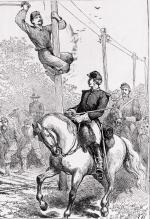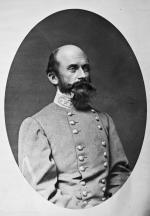![header=[Marker Text] body=[Over this route Confederate General R. S. Ewell's 2d Army Corps led Lee's invading forces on June 22, 1863. Next day Gen. Jubal Early, under Ewell's command, entered the State to the east, near Waynesboro] sign](http://explorepahistory.com/kora/files/1/10/1-A-1D7-139-ExplorePAHistory-a0h2j9-a_450.jpg)
Mouse over for marker text
Name:
Gettysburg Campaign [Invasion]
Region:
Hershey/Gettysburg/Dutch Country Region
County:
Franklin
Marker Location:
US 11, 1 mile north of State line.
Dedication Date:
December 5, 1947
Behind the Marker
Today Route 11 generally follows the same path that it occupied back in 1863. This important road runs down the middle of the Cumberland Valley, passing through Carlisle, Shippensburg, Chambersburg, and Greencastle. During the American Civil War, any invading force would have to rely on this route as a main axis of advance toward Harrisburg.
When the Confederate army under General Robert E. Lee invaded Pennsylvania in June of 1863, the Second Corps, once led by the famed Stonewall Jackson, led the way. Now it was under the command of Lieutenant General Richard S. Ewell or "Old Bald Head," as he was known to his men.
Ewell, born in Virginia in 1817, was a West Point Graduate who had seen years of service during the Mexican American War and fighting Indians in the west. When the Civil War erupted, Ewell became a division commander under Jackson and was a rising star until a bad wound in August 1862 cost him his right leg. Returning to active service in May 1863, with an artificial limb, Ewell took command of Jackson's old corps.
Store clerk Jacob Hoke saw Ewell ride into Chambersburg in a carriage, a mode of transportation made necessary by his missing leg. "One of the occupants of this carriage," Hoke observed, "was a thin, sallow-faced man, with strongly-marked Southern features, and a head and physiognomy which strongly dictated culture, refinement and genius." All true. But what Hoke didn't know was that Ewell was also widely-known throughout the Army of Northern Virginia for his cursing.
When planning his movement north of the Potomac River, Lee gave Ewell's corps the advance. Lee probably wished to give Ewell a chance to prove himself a worthy successor to Jackson. He also remembered that Ewell had at one time served as a civil engineer on the Columbia Railroad in Lancaster County and been stationed at the army barracks at Carlisle.
Ewell's corps began the campaign by routing the Union garrison at Winchester, Virginia. The corps then crossed the Potomac River. Camping near Williamsport, Maryland, Major General Robert Rodes began to receive herds of cattle that Brigadier General Albert G. Jenkins' cavalry had rounded up and sent to the rear to feed the army. Rodes was not amused by Jenkins' retreat from Chambersburg on the 17th, when the horsemen fell back to the Hagerstown area close to Rodes' infantry units. Yes, agreed Rodes, Jenkins' men had accumulated large herds of cattle and sent them south, but most of the horses rounded up were largely unaccounted for, apparently retained by Jenkins' men for new mounts.
Chambersburg on the 17th, when the horsemen fell back to the Hagerstown area close to Rodes' infantry units. Yes, agreed Rodes, Jenkins' men had accumulated large herds of cattle and sent them south, but most of the horses rounded up were largely unaccounted for, apparently retained by Jenkins' men for new mounts.
On June 18th, Ewell gave Rodes new orders. The next morning, his five brigades of infantry, more than 8,000 veteran soldiers, marched to Hagerstown, feinted toward Harpers Ferry to scare the Yankees garrisoning that point, and then headed towards Chambersburg in Pennsylvania.
On June 21, Ewell's other two divisions-those of Jubal A. Early and Edward Johnson-camped near Rodes' troops. Ewell then gave the go ahead to cross the Mason-Dixon Line into Pennsylvania. On June 22, Brigadier General Alfred Iverson's North Carolinians became the first Confederate infantry to march northward into Yankee territory. The invasion had begun!
When the Confederate army under General Robert E. Lee invaded Pennsylvania in June of 1863, the Second Corps, once led by the famed Stonewall Jackson, led the way. Now it was under the command of Lieutenant General Richard S. Ewell or "Old Bald Head," as he was known to his men.
Ewell, born in Virginia in 1817, was a West Point Graduate who had seen years of service during the Mexican American War and fighting Indians in the west. When the Civil War erupted, Ewell became a division commander under Jackson and was a rising star until a bad wound in August 1862 cost him his right leg. Returning to active service in May 1863, with an artificial limb, Ewell took command of Jackson's old corps.
Store clerk Jacob Hoke saw Ewell ride into Chambersburg in a carriage, a mode of transportation made necessary by his missing leg. "One of the occupants of this carriage," Hoke observed, "was a thin, sallow-faced man, with strongly-marked Southern features, and a head and physiognomy which strongly dictated culture, refinement and genius." All true. But what Hoke didn't know was that Ewell was also widely-known throughout the Army of Northern Virginia for his cursing.
When planning his movement north of the Potomac River, Lee gave Ewell's corps the advance. Lee probably wished to give Ewell a chance to prove himself a worthy successor to Jackson. He also remembered that Ewell had at one time served as a civil engineer on the Columbia Railroad in Lancaster County and been stationed at the army barracks at Carlisle.
Ewell's corps began the campaign by routing the Union garrison at Winchester, Virginia. The corps then crossed the Potomac River. Camping near Williamsport, Maryland, Major General Robert Rodes began to receive herds of cattle that Brigadier General Albert G. Jenkins' cavalry had rounded up and sent to the rear to feed the army. Rodes was not amused by Jenkins' retreat from
On June 18th, Ewell gave Rodes new orders. The next morning, his five brigades of infantry, more than 8,000 veteran soldiers, marched to Hagerstown, feinted toward Harpers Ferry to scare the Yankees garrisoning that point, and then headed towards Chambersburg in Pennsylvania.
On June 21, Ewell's other two divisions-those of Jubal A. Early and Edward Johnson-camped near Rodes' troops. Ewell then gave the go ahead to cross the Mason-Dixon Line into Pennsylvania. On June 22, Brigadier General Alfred Iverson's North Carolinians became the first Confederate infantry to march northward into Yankee territory. The invasion had begun!






